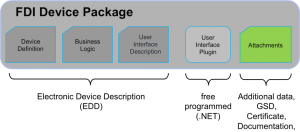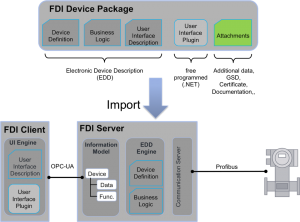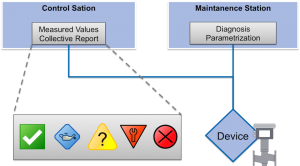Departure for New Worlds
The chemical industry is well acquainted with networks. Many locations operate in close raw material and energy networks. This is now to be extended to the data level – or at least the measured value level. For it is apparent that analog measured value transmission in chemical plants is often no longer adequate for future tasks. For this reason, the process industry is now openly discussing the topic of Industrie 4.0 and the use of Ethernet technologies.
Competitive pressure in the process industry is increasing. New ways of making production more efficient are being sought. This is accompanied by a trend toward smaller batches and customized products that nevertheless require intelligent process control. New approaches are therefore needed in the future for items such as remote parameter assignment of instrumentation for optimizing control loops and automatic data acquisition of measurement series in an ERP system. In addition, the whole subject of modularized plants is only partially covered with existing automation technologies.
This has led to increasing discussion over the past two years of aspects such as Industrie 4.0, networked production, and intelligent communication. Accordingly, the use of Ethernet technologies in the process industry is now conceivable. This is particularly true because PROFINET is shaping up as the backbone for Industrie 4.0 applications in other industries. Manufacturers have followed suit by offering more and more field devices with a PROFINET interface, ranging from flow meters to data recorders, for example. In this way the portfolio is being gradually expanded and the introduction to PROFINET is being made easier for process industry users as well.
Gradual Transition to the Industrie 4.0 World
PROFIBUS DP is already being gradually replaced by PROFINET in factory automation. A similar trend is also anticipated in process automation. However, the hurdles in the process industry are somewhat higher. The production process, which is often continuous, cannot be easily stopped and when problems occur the potential for harm to humans and the environment is usually high. Apart from that, an unscheduled stoppage results in high financial losses. What is needed, therefore, are easy to use solutions that are characterized by high performance capability with regard to availability, flexible topologies, robust connection technology, redundancy, and consistency – even over long distances. Explosion protection also plays a role. At the same time, the technologies should have a long service life – in view of long life cycles of 20 years and more.
Nevertheless, implementation is further along than it seems at first glance. In recent years, PROFIBUS & PROFINET International (PI) has brought about numerous technological developments that meet these requirements. These include topics such as PROFINET for the process industry, diagnostics and condition monitoring, integration with FDI, PROFIenergy, and PROFINET Security.
Especially important to the teammates of PI is that these technologies are sustainable; that is, they will still be usable decades from now. This will be achieved mainly through open technology but also through the fact that close collaboration with users, manufacturers, and other organizations is taking place at an early stage. This is the only way that a joint standard can be developed that meets all requirements. Against this backdrop, the reference architecture model Industrie 4.0 (RAMI4.0) is currently playing a major role. RAMI 4.0 was developed by an interest organization made up of the BITKOM, VDMA, ZVEI, and VDI associations and the IEC and ISO standards organizations with their national bodies DKE and DIN. Despite the somewhat unwieldy name, the model was introduced to simplify the work on Industrie 4.0. The background for this type of reference architecture model is enable tasks and sequences to be broken down into manageable parts. As a result, the transition to the world of Industrie 4.0 can take place gradually. If multiple standards exist for the same thing or similar things from the view of the model view, a preferred standard in the reference architecture model can be discussed.
In detail, layers of different view points, such as data image, functional description, communication characteristics, hardware/assets, and business processes, are used in the vertical axis of the model. The product life cycle is mapped onto a horizontal axis. The location of functionalities and responsibilities within the plants is established on a third axis. Six layers describe machines, components, and plants.
Using a flow meter as an example, it will be shown how the RAMI model works in practice and how the technologies of PROFIBUS and PROFINET are already contributing to Industrie 4.0. A flow meter is clearly described and identifiable in the RAMI model as a device (Asset Layer). The Integration Layer contains device descriptions, from the EDDL or FDT/DTM, or in the future FDI.

PROFIBUS and PROFINET are intrinsically found in the Communication Layer. Ultimately, PROFINET combines horizontal and vertical integration with its integrated Ethernet communication, thus establishing a direct communication connection to the corporate management level and across production locations.
The service and maintenance functions (I&M functions) of PROFINET contain, for example, the running time and make this available in the Information Layer. The different profiles are affiliated there. As a result, it is possible not only to transfer pure data but also to semantically augment it as well. In this way, the PA profile not only defines a measured value but it also names units, limits, etc. Such additional data is necessary for preventive maintenance, e.g., for specifying process-related conditions.
In the Functional Layer, the profiles provide specific functions such as parameters and diagnostic information (from the GSD file) for each measurement principle and actuator, independent of device model and manufacturer. With this information, the field device reacts to events in the real world (e.g., a fault) and executes an action in the digital world.
The Business Layer ultimately allows modeling of business-relevant processes and offers the options of linking together the information and functions provided in the other levels for realization of new business models. A possible application would be the exchange of calibration data between a company and a calibration service provider. This provider performs the calibration and directly stores the new expiration dates in the customer system. Because live data are involved, it is possible to prioritize especially heavy-duty devices, for example.
Secured Access to Sensitive Data
Whatever data is collected, it is crucial that these data are collected in a type of secured container in the course of the life cycle. Other companies, machines, and plants can thus access it reaction-free. The FDI (Field Device Integration) technology shows one idea of how reaction-free access might function. FDI standardizes the integration of configuration and diagnostic tools of field devices in a Plant Asset Management System. The advantages are, briefly, the standardized user interface, the access to special functions, and that a Big Data integration via OPC UA is possible.
 The reference architecture model expressly names the FDI technology as an effective means. With its device information model (set forth in IEC 62541-100), the client/server architecture of FDI technology provides all functions for modeling real devices as virtual objects for the industrial Internet of Things. It is interesting to note that the initiative for development of the FDI technology began before the term Industrie 4.0 was even invented. This shows that many developments have prevailed even without the term ‘Industrie 4.0’ simply because users need them.
The reference architecture model expressly names the FDI technology as an effective means. With its device information model (set forth in IEC 62541-100), the client/server architecture of FDI technology provides all functions for modeling real devices as virtual objects for the industrial Internet of Things. It is interesting to note that the initiative for development of the FDI technology began before the term Industrie 4.0 was even invented. This shows that many developments have prevailed even without the term ‘Industrie 4.0’ simply because users need them.
PROFIBUS PA to Become the Key Technology
The basis for Industrie 4.0 applications is PROFINET, which masters both fast transmission of small data quantities and efficient transmission of large data quantities with simultaneous protection of real-time capability. Critical for process industry users is the inventory protection of installed automation components. For this reason, the following points are currently in the foreground of development activities:
- Inventory protection of instrumentation with legacy systems
- Migration strategies from PROFIBUS to PROFINET
- Connection and installation technology of Ethernet-based devices in process technology
 PI sees PROFIBUS PA as the current key technology for digitization of field communication. PROFIBUS PA enables long cable distances and explosion protection for the harsh environments of process automation and offers complete digital integration of field instrumentation in control and asset management systems. The connection is made using a link/coupler typically via PROFIBUS DP. The user benefits of PROFIBUS PA result from, among other things, the use of digital instead of analog communication with all the positive consequences from this, the suitability for especially easy proof of intrinsic safety type of protection (FISCO Model), and the properties of the PA 3.02 device profile oriented to the process industry. The fieldbus combination “PROFIBUS DP with connected PA segment” is currently being used in many installations worldwide, where it is proving itself over and over as a high-performance and stable solution.
PI sees PROFIBUS PA as the current key technology for digitization of field communication. PROFIBUS PA enables long cable distances and explosion protection for the harsh environments of process automation and offers complete digital integration of field instrumentation in control and asset management systems. The connection is made using a link/coupler typically via PROFIBUS DP. The user benefits of PROFIBUS PA result from, among other things, the use of digital instead of analog communication with all the positive consequences from this, the suitability for especially easy proof of intrinsic safety type of protection (FISCO Model), and the properties of the PA 3.02 device profile oriented to the process industry. The fieldbus combination “PROFIBUS DP with connected PA segment” is currently being used in many installations worldwide, where it is proving itself over and over as a high-performance and stable solution.
The proxy specification now allows the integration of today’s installations (e.g. PROFIBUS DP/PA, HART) as well as future installations in PROFINET environments. With the use of these proxies, it becomes possible to combine the strengths of two technologies already proven for years in practice (PROFIBUS PA and PROFINET) and thus also to ensure investment protection for other established technologies over the long term.
Outlook
PROFINET provides an open solution platform based on Fast Ethernet. This is designed compatibly with today’s existing technologies and for the long term. The result will be a PA Device Profile 4.0 that can be used uniformly with PROFIBUS and PROFINET systems. Examples of the resulting user benefits include the significantly easier and uniform processes for engineering, installation, commissioning, and replacement of devices. For vendor-neutral configuration of field devices in the control system, devices with the PA profile offer a standard interface in the form of the “neutral channel”, which represents the combined functions of the devices and provides these in the form of an expanded profile GSD for the device integration. The transmission of large data quantities made possible by Industrial Ethernet expands the former data exchange into an information exchange. As a result, not only data and keywords but also meaningful information from the entire plant is made available to the owner.
PI is also contributing to the field of activity on security – another important issue that many potential users are keeping an eye on. These endeavors show that with the help of current technologies, future concepts such as Industrie 4.0 and Big Data can already be realized today.
